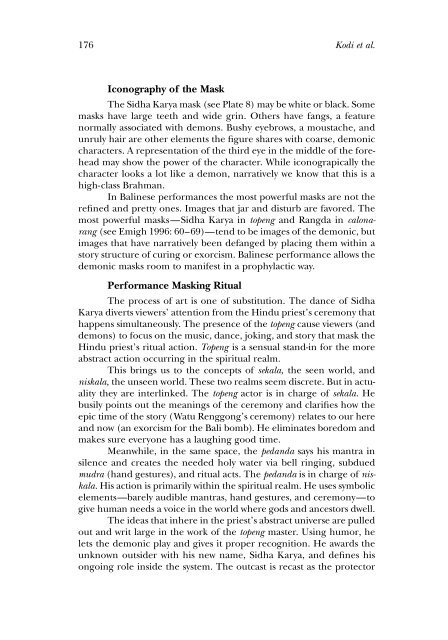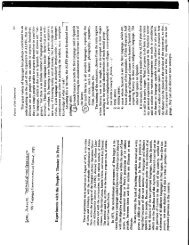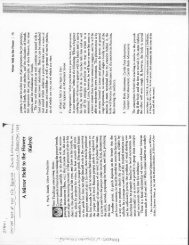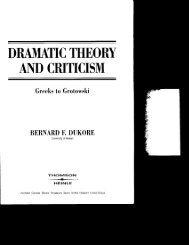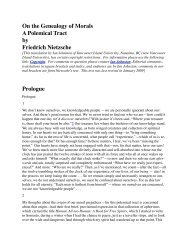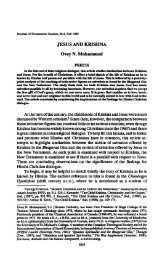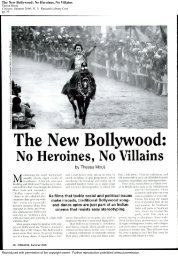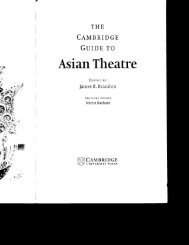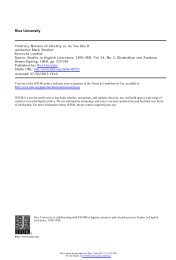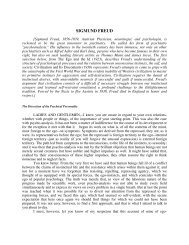Topeng Sidha Karya: A Balinese Mask Dance - Yavanika
Topeng Sidha Karya: A Balinese Mask Dance - Yavanika
Topeng Sidha Karya: A Balinese Mask Dance - Yavanika
- No tags were found...
Create successful ePaper yourself
Turn your PDF publications into a flip-book with our unique Google optimized e-Paper software.
176 Kodi et al.Iconography of the <strong>Mask</strong>The <strong>Sidha</strong> <strong>Karya</strong> mask (see Plate 8) may be white or black. Somemasks have large teeth and wide grin. Others have fangs, a featurenormally associated with demons. Bushy eyebrows, a moustache, andunruly hair are other elements the figure shares with coarse, demoniccharacters. A representation of the third eye in the middle of the foreheadmay show the power of the character. While iconograpically thecharacter looks a lot like a demon, narratively we know that this is ahigh-class Brahman.In <strong>Balinese</strong> performances the most powerful masks are not therefined and pretty ones. Images that jar and disturb are favored. Themost powerful masks—<strong>Sidha</strong> <strong>Karya</strong> in topeng and Rangda in calonarang(see Emigh 1996: 60–69)—tend to be images of the demonic, butimages that have narratively been defanged by placing them within astory structure of curing or exorcism. <strong>Balinese</strong> performance allows thedemonic masks room to manifest in a prophylactic way.Performance <strong>Mask</strong>ing RitualThe process of art is one of substitution. The dance of <strong>Sidha</strong><strong>Karya</strong> diverts viewers’ attention from the Hindu priest’s ceremony thathappens simultaneously. The presence of the topeng cause viewers (anddemons) to focus on the music, dance, joking, and story that mask theHindu priest’s ritual action. <strong>Topeng</strong> is a sensual stand-in for the moreabstract action occurring in the spiritual realm.This brings us to the concepts of sekala, the seen world, andniskala, the unseen world. These two realms seem discrete. But in actualitythey are interlinked. The topeng actor is in charge of sekala. Hebusily points out the meanings of the ceremony and clarifies how theepic time of the story (Watu Renggong’s ceremony) relates to our hereand now (an exorcism for the Bali bomb). He eliminates boredom andmakes sure everyone has a laughing good time.Meanwhile, in the same space, the pedanda says his mantra insilence and creates the needed holy water via bell ringing, subduedmudra (hand gestures), and ritual acts. The pedanda is in charge of niskala.His action is primarily within the spiritual realm. He uses symbolicelements—barely audible mantras, hand gestures, and ceremony—togive human needs a voice in the world where gods and ancestors dwell.The ideas that inhere in the priest’s abstract universe are pulledout and writ large in the work of the topeng master. Using humor, helets the demonic play and gives it proper recognition. He awards theunknown outsider with his new name, <strong>Sidha</strong> <strong>Karya</strong>, and defines hisongoing role inside the system. The outcast is recast as the protector


